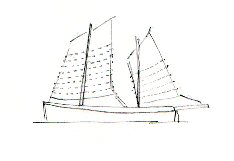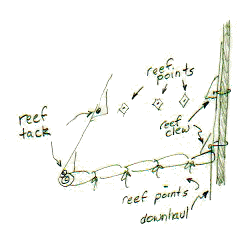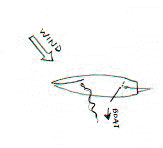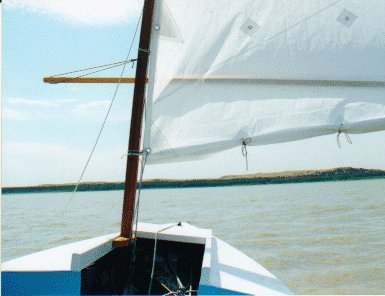The other day I made a statement on one of the internet discussion groups to the effect
that "…I think effective reefing is the most important factor in determining the
seaworthiness of a small boat…" Chuck responded by asking me to write up my
thoughts on sail reefing. He even sent me some very fine reading about old fashioned sail
rigs. I told him that I am certainly no expert, but I would be willing to record my own
personal experiences. So from an amateur's point of view…--------
I've sailed small boats all of my life, but it was a long time before I
started to think of reefing as an every day sail handling skill rather than an emergency
tactic. When I finally did start setting my sails to match the wind conditions, it came as
a revelation that heavy weather sailing doesn't have to involve acrobatic hiking on the
windward rail or raw hands from gripping the sheet. In fact, I discovered that with good
sail management, heavy weather sailing can be fun, fast and safe.
Of all the small boats I've sailed, my two favorites are:
Drascombe Longboat - A very seaworthy open boat (21'), but doesn't point well. When
my dad first got her, we didn't take advantage of the features of the sail plan and so we
wound up hiking and heeling and burning our hands holding onto the sheets. I borrowed the
boat from my dad for about 13 years and it was during this period that I really learned
how to match the boat to the wind. I've done some silly things with this boat and sailed
in some terrible weather in the Gulf of Mexico and the Chesapeake, but she has always
brought me home, largely because of her sail rig. Side note: this boat is ample proof that
an open, unballasted boat can be very seaworthy.
AF3 - a fast little sharpie skiff (16') with a cuddy cabin designed by Jim
Michalak. My current Boat. It has one sail
with two reefs. It took me about 170 hours to build the boat and sew the sail. My family
and I recently took her out for a weekend in steady 25 knot winds and had a wonderful time
with no worries. We had one reef tied in the whole time, sailing beam reaches or broad
reaches. We would have had to tie a second reef in if we had needed to head upwind. We
camped five miles down the beach, knowing that we could get home in the morning even if
the wind shifted.
Why reef:
Jim Michalak recently mentioned in one of his excellent
essays that force on a sail is proportional to the square of the wind velocity. If the
wind doubles from 5 to 10 knots, the force on the sail will increase by four times. This
is the reason why reefing is so important. I found a description of a Scotland
"Fifie" in John Leather's "Spritsails and Lugsails." It was used for
fishing along the North Sea coast of Scotland around 1905 and had eight lines of reef
points on the main and five on the mizzen.

Fig 1. Scottish Fife
Other similar craft carried complete sets of smaller heavy weather sails for the same
purpose. Howard Chapelle, in his "American Small Sailing Craft," describes how
oyster and crabbing sharpies carried two masts with three mast steps. In light winds, both
masts were stepped fore and aft. In heavier winds, a single mast was stepped in the middle
mast step. Bluewater cruising literature is full of heavy weather sail handling
information that, while not aimed at the small boater, is still relevant. For instance,
cruisers seem to prefer cutters and ketches because their sail shortening options are
better than with other rigs.
There are as many different reefing schemes as there are sail plans. To my mind, there are
two important measures of a reefing system:
1) Does it works when you really need it to work.
It seems to me every other emergency at sea story involves some sort of problem with
reefing - either the furling drum has jammed, or sail doesn't come down etc. For this
reason, I consider reliability more important than convenience when it comes to reefing.
In the engineering world, "Mean Time Between Failure" is used as one
measure of reliability. I would love to know the average MTBF for roller furling jibs at
any given marina in the US. I bet it is a terribly low number. Among blue water cruisers,
whose life depends on such gear, I am sure the number is much better.
In most aspects of sailing, and most particularly in reefing, the probability of failure
is highest at the moment where the consequences of failure are the worst (unlike my car,
where the probability of failure is greatest when I go to start it). Generally, mechanical
systems with fewer parts are more reliable than systems with more parts, so my personal
bias is toward simple reefing systems. Complex systems can be reliable, but they are more
expensive than simple systems and usually require more recurring attention in order to
achieve that reliability. This is one reason why I like the old fashioned rigs like the
sprit-boom and the loose footed main.
2) Does the boat sail well when reefed.
I think a rig that is unbalanced or can't point under reefed sails is not much better than
one with no reefing options. The whole point of reefing is to manage the boat so that you
can get to where you are going in various wind conditions. Besides being inconvenient,
sailing an unbalanced boat in heavy weather is unsafe.
When to reef:
The saying goes: "reef early and reef often." I find that above 10 knots, I
adjust my sail area for every 5 knot increase in wind, depending on point of sail. A small
boat, especially an unballasted one, is more sensitive to sail area when going upwind, so
I am more likely to reef if I have any upwind work ahead. I also think it is crucial to be
able to reef while underway, even in a small boat. This may not be important for someone
who will always be sailing within site of the dock, but I like exploring and going from
place to place, so I need to know that I can get back home, even if the wind changes or
picks up.
How I reef:
"Swallows and Amazons," by Arthur Ransome talks about reefing: Mum quizzes her
sons John and Roger on reefing the lugsail of the Swallow. Roger explains that you first
tie the pendant nearest to the mast, then the one at the end of the boom, followed by the
reef points in between. So far, after 26 years, that has been my only instruction!
The Drascombe Longboat, which Phil Bolger would call a Jib Headed Gunter Yawl (see his
book "103 sailing rigs, straight talk") has a roller furling jib, a loose footed
main with two sets of reef points and a small balancing mizzen aft of the tiller. When
reefing the main, I always lower the main completely. She is very well balanced under jib
and mizzen alone, so if I have a crew, we keep going underway while reefing. If I am
single handing, then I heave-to, drop the sail, free the mainsheet, free the downhaul and
clip it to the first reef tack tie the reef points, clip the mainsheet to the reef clew,
then raise the sail and continue on (I have stainless carbiner clips on both the mainsheet
and the downhaul to make reefing easier).

Fig. 2 - Reefing parts of a sail
To heave-to, I back-wind the jib (sheet it in on the windward side), let the main sail fly
loose or lower it, haul in the mizzen and put the tiller hard to lee. The result of all
this is that the boat very gently drifts to leeward, keeping her bow about 30 or 40
degrees to the wind.

Fig. 3. Heaving-to in the Drascombe
As the wind increases my order of sail shortening usually goes like this:
1. Full sail 2. single reef main 3. furl jib 20% 4. double reef main 5. furl jib 50% 6.
drop main OR furl jib and mizzen 7. mizzen only (downwind only). Sometimes I heave-to to
wait out squalls instead of running with the wind or heading in to shelter.

Fig 4. Drascombe Sail Sets
My AF3 is a cat rigged sprit-boomed sharpie skiff. Chapelle indicates that early sharpies
of the 1870's had vertical reefing, the sail being drawn up to the mast with brails. Later
boats used horizontal reef points. Jim Michalak has tried vertical reefing on his sails,
but was unhappy with the results. I put horizontal reefs into my AF3 sail and so far, they
have worked out very well. Some people do not rig a halyard on this type of rig. They
simply leave the sail tied to the mast and roll it up when not in use. I have a halyard.
On some sharpie designs, owners reef by removing the sprit boom and roll the main around
the mast. I haven't tried this on the AF3 but I suspect the upwind sail performance would
suffer greatly because the absence of the sprit boom would ruin the sail shape. Since
there is only one sail, there is no possibility of heaving-to or staying underway while
reefing. There is, however a very nice cuddy cabin that gives the sail plenty of
protection from the wind while I am tying the reef points.
 
Fig 5,6. AF3 mainsail with one reef tied in
To reef, I lower the sail completely, remove the sprit boom, free the downhaul and re-lace
it to the first reef cringle. Then I the tie the reef points starting with the one
farthest from the ends going inward, refasten the sprit boom and raise the sail. I haven't
had boat for very long, so I don't have much practice, but so far the whole operation
takes about five minutes - about twice as long as on the Drascombe. I'd like to get it
down to two and a half minutes, so I plan on adding a few clips or shackles and other
features to sprit boom and mainsheet to make things go faster.
Conclusion
I think the ability to effectively manage sail area, regardless of rig type, is a
fundamental part of sailing and seamanship. For small boats, I prefer simple sail rigs
with few moving parts. I have only recently started reading about the pre-industrial sail
powered fishing boats, but I have learned a lot by simply studying their rigs.
|